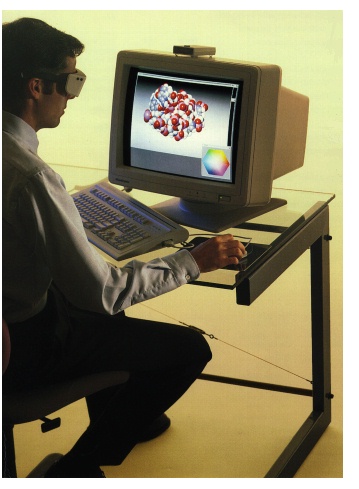Now your 3D databases can be viewed with 3D software on 3D workstations in real 3D from Silicon Graphics. StereoView is our high-quality, low-cost solution to real stereoscopic viewing of images on Silicon Graphics 4D systems. This add-on productivity tool enhances your ability to view complex three-dimensional technical data.
What is stereoscopic viewing?
 Our ability to view the world with two eyes is called binocular or
stereoscopic vision. After receiving two slightly different views of
the world, our brain integrates these into one coherent
three-dimensional picture. This stereoscopic ability is very
important to maneuvering in and understanding the world around us
Visual communication media such as drawings, photographs, television,
and computer graphics displays present an inherently flat view
of the world, as each eye receives the same view. The
important stereoscopic visual cue is lost.
Our ability to view the world with two eyes is called binocular or
stereoscopic vision. After receiving two slightly different views of
the world, our brain integrates these into one coherent
three-dimensional picture. This stereoscopic ability is very
important to maneuvering in and understanding the world around us
Visual communication media such as drawings, photographs, television,
and computer graphics displays present an inherently flat view
of the world, as each eye receives the same view. The
important stereoscopic visual cue is lost.
Various schemes have been used over the years to provide each eye with a unique stereo view and to trick the brain into seeing real 3D where none exists. Up until StereoView, the attempts to do this with computer graphics displays have either been too expensive, or too awkward, or both to meet with wide acceptance.
The StereoView system
StereoView consists of two items - specially designed eyewear and an infrared emitter. The eyewear uses the fastest switching and most translucent Liquid Crystal Shutter (LCS) technology available. The shutters alternately open and close every 120th of a second in conjunction with the alternating display of the left and right eye view on the display - presenting each eye with an effective 60 Hz refresh. The infrared emitter transmits the left/right signal from the IRIS 4D graphics system to the wireless eyewear so that the shuttering of the LCS is locked to the alternating left/right image display. As a result, each eye sees a unique image and the brain integrates these two views into a stereo picture. The monitor provides 120 Hz flicker-free operation in stereo mode, and 60 Hz operation in mono mode.
Stereoscopic applications
Anyone needing to understand complex 3D models or relationships on a computer system can get a step closer to reality with StereoView. With 3D stereo, chemists involved in molecular design and analysis can better understand the intricate three-dimensional molecules they study and their interactions. Scientists trying to visualize and understand computational fluid dynamics are aided dramatically with the additional visual cues that 3D stereo brings. Likewise, 3D stereo enhances visual simulation applications, and gives engineers an increased understanding of complex conditions in C(3)I applications.
Silicon Graphics Geometry Partners use StereoView in a broad range of applications:
Key features
Eyewear Lenses Surface mode achromatic LC devices
Transmittance 32 percent typical
Dynamic range 100-1 typical minimum
Close time .02 millisecond (typical)
Open lime 2.5 milliseconds (typical)
Field rate from 90 to 150 fields per second
Batteries Two 3V lithium/manganese dioxide
NEDA5004L including:
Duracell DL2032
Eveready E-CR2032
Maxell CR2032
Panasonic CR2032
Ray-O-Vac CR2032
Salt LM2032
Seiko CR2032
Technacell CR2032
Vana CR2032
Operational life 200 hours of continuous operation
(typical)
Weight 85 grams
Instrumentation ON/OFF button, STEREO and PSUEDO
buttons, 3D/BRITE button
Shutdown mode Power turns off after 16 minutes
of non-use
Emitter Inputs DB-9, power and sync.
Edge-triggered
Infrared 160 degree dispersion cone, 8 foot
dispersion radius on HI, 4 foot radius on LO
Power 8 to 18 volts. AC or OC at 50
milliamps maximum
Size 4.6" x 2.8" x 1.0" (approximate)
Weight 5 oz. (approximate)